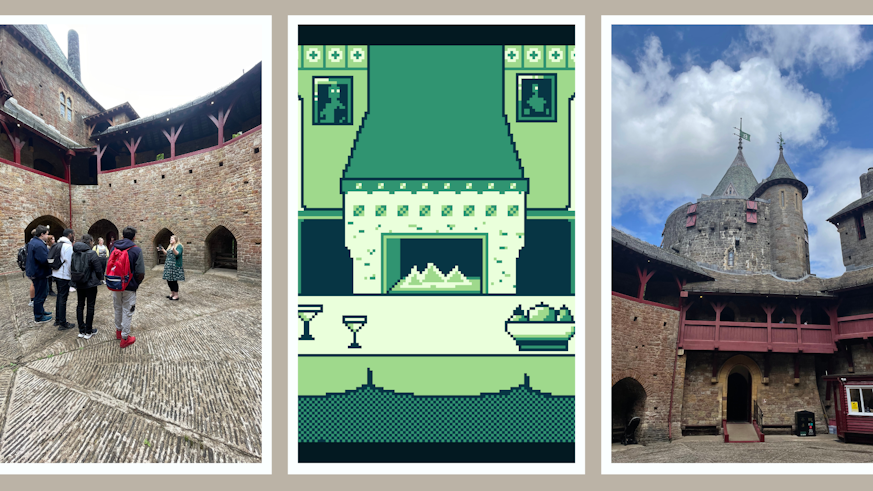When gaming meets Cardiff history
23 October 2023

Using video games to engage with the history and heritage of Cardiff and southeast Wales
Cardiff University students from Computer Science and History are combining their skills to help capture the imagination of new generations in exciting collaborations across the city.
Now heading into its fourth year, the Cardiff Heritage Jam is a programme of activities designed to investigate how gaming technology can make history and heritage more engaging for young minds.
Together, undergraduate and postgraduate students from the School of History, Archaeology and Religion and School of Computer Science and Informatics have been designing game prototypes inspired by some of the capital’s special spaces and heritage.
The interdisciplinary initiative is a result of the shared interests of two academics with very different expertise: Dr Esther Wright and Dr Daniel J. Finnegan.
“While we both approach video games – especially those that engage with the past – from the different disciplinary approaches of the Humanities and STEM, we are really keen to understand the potential value of digital media and gaming to help people engage with shared history and heritage” says Lecturer in Digital History Dr Esther Wright.
The activities have also been designed to help students from these different disciplinary backgrounds see themselves in game development roles.
Senior Lecturer in Computer Science Dr Daniel J. Finnegan explains:
“The experience is beneficial for students from both disciplinary backgrounds: history students gain hands-on experience with game design software, and computer science students benefit from a sense of the practicalities of historical and background research, which is crucial when writing a game’s narrative.”
The Cardiff Heritage Jam works through collaboration with existing Cardiff University research and engagement projects, as well as external heritage organisations and charities.
In the latest partnership with Cadw, two teams of students spent two days at Castell Coch immersing themselves in over 700 years of history.
Reader in Welsh History and History Dr Marion Löffler gave the students expert guidance on Castell Coch’s context within the wider history of Wales:
‘Built as part of a chain of Norman military castles, enlarged by “red” Gilbert de Clare and ruined in the late Middle Ages, Castell Coch was rediscovered when the Industrial Revolution led to romantic yearnings for simpler ages. The third Marquess of Bute decided to spend his father’s and grandfather’s money on his medievalist vision, which included rebuilding, equipping it with a lavish interior, and surrounding it with a working vineyard, before running out of money and handing all over to Cardiff Corporation.’
Cadw's Head Custodian for Castell Coch and Caerphilly Castle, Cori-Lee Blackman (Archaeology & Ancient History, BA 2008) adds:
“As a long-time worker in the Heritage sector, I am keen to open up heritage doors to demographics of visitors we don’t traditionally see onsite. It is also fascinating to see the different takes on the monument and its past being expressed in the games students produced.”
In just a few weeks, the teams planned out the kinds of stories they wanted to tell, the audience they imagined for their games, and the experience they wanted players to have of them. After an intensive game development workshop, working with game design tools and software such as GB Studio, the students developed their game prototypes: Breaking Bute and Pixel Quest both playable via Itch.io.
The Cardiff Heritage Jam started life as a remote summer school in 2021, partnering with the CAER Heritage Project. Inspired by archaeological finds over 6,000 years of settlement uncovered on the site of Caerau and Ely’s hidden hillfort, students collaborated remotely via gather.town to create games which incorporated a range of artifacts.
In the years since, students have engaged with the history of Cardiff Royal Infirmary in collaboration with Cardiff and Vale University Health Board’s Arts for Health and Wellbeing Charity and with the story of Grangetown and its new Grange Pavilion, thanks to the University’s Community Gateway project.
This year, the Cardiff Heritage Jam widened participation yet further to students from the School of Journalism, Media and Culture, supported by the University’s Arts, Humanities and Social Science College Seedcorn Building Communities fund and the School of Computer Science and Informatics.
Heritage Jam participant Salsabilla Sakinah is studying for a PhD at the School of Journalism, Media and Culture. She says:
“I’m very grateful to have the opportunity to participate in the Cardiff Heritage Jam this year. As a person who had no previous coding experience, the workshop taught me some simple technical skills, software, and confidence to build a game, as well as other transferrable skills such as communication and teamwork. I also got new insights about heritage in gaming context, which is undoubtedly very useful for my current work and research project.”
